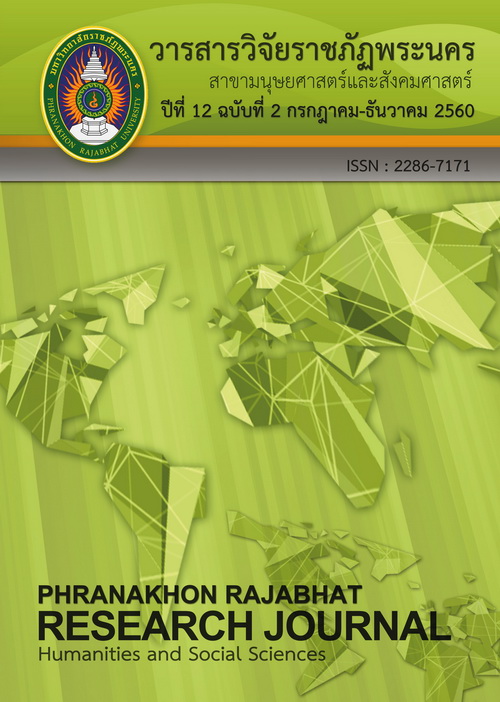รูปแบบความสัมพันธ์เชิงสาเหตุของปัจจัยวัฒนธรรมการทำงาน และปัจจัยคุณภาพชีวิตในการทำงานที่มีผลต่อ ความผูกพันของบุคลากรการไฟฟ้าส่วนภูมิภาค
Main Article Content
Abstract
This research aimed to study the relationships between organizational culture, quality of work life and employee commitment of Provincial Electricity Authority and to study the direct and indirect influences of organizational culture, quality of work life on employee commitment of Provincial Electricity Authority and to investigate the causal relationship model between organizational culture and quality of work life on employee commitment of Provincial Electricity Authority. The research selected sample from Provincial Electricity Authority staff by Stratified Sampling for best sample and questionnaire was used as the tool for data collecting. The questionnaire was designed according to theory and operational definition.The statistics
used in this research included, 1) Simple correlation analysis which was to investigate the relationships of organizational culture, quality of work life and employee commitment of Provincial Electricity Authority 2) Multiple regression which was to acquire the standard regression coefficient, path coefficient from the structure equation model in order to find out direct and indirect influences of independent variable towards dependent variable.
The results were as follows: 1) Overall the independent variables that organization culture and quality of work life related to employee commitment of Provincial Electricity Authority under study were evinced at the statistically significant level of .05. 2) The independent variables had direct influences on employee commitment of Provincial Electricity Authority. The factors which influence the employee commitment are as follows; quality of work life in social relevance of work life, quality of work life in the total life space, mission culture and quality of work life in adequate and fair compensation. 3) Mission culture, Bureaucratic
culture, Adaptability culture and Involvement culture that indirect influence on employee commitment of Provincial Electricity Authority in term of quality of work life in adequate and fair compensation, quality of work life in the total life space and quality of work life in social relevance of work life
Article Details
Each publish articles were copyright by Phranakorn Rajabhat University
Any contents which appeared in each articles in the journal were authors personal opinion. It did not relate to Phranakorn Rajabhat University and other instructors in the university. Each authors would take responsibility on their articles. If there are any mistake, the authors will take responsibility themselves
References
commitment to the organization. Journal of Occupational Psychology, 12(63), 1-18.
Barney, J.B. (1986). Organizational culture: can it be a source of sustained competitive advantage? Academy of Management Review. 11(3), 656–665.
Beeri, I., Dayan, R., Vigoda-Gadot, E. & Werner, S. (2013). Advancing ethics in public organizations: the impact
of an ethics program on employees perceptions and behaviors in a regional council. Journal of Business
Ethics, 112(1), 59-78
Cameron, K.S. & Quinn, R.E. (1999). D i a g n o s i n g a n d c h a n g i n g organizational culture: based on
the competing values framework. Massachusetts: Addison-Wesley.
Chalofsky, N. (2003). Meaningful work : This part 1 in a three-part series focuses on the classicTheories and
new studies on why people need meaningful work and the implications for organizations. T & D, 57(12),
270-285.
Daft, R.L. (2008). The Leadership Experience. 4th ed. Mason, O.H.: Thomson/South-Western.
Hoonakker, P., Marian, A. & Carayon, P. (2003). The relation between job characteristics and quality of working
life : the role of task identity to explain gender and job type differences. Proceedings of the Human Factors
and Ergonomics Society 48th Annual Meeting, New Orleans, Louisiana, 20, 1571-1575.
Kanjanawasee, S. (2007). Multilevel analysis. 4th ed. Bangkok: Chulalongkorn University Printing House. (in Thai)
Kinicki, A. & Kreitner, R. (2009). Organizational behavior: key concepts, skills & best practices. 4th ed. Boston: McGraw-
Hill Irwin.
Lawal, O. & Oguntuashe, K. (2012). Impacts of organizational leadership and culture on organizational trust: Role
of job cadre. IFEPsychologia, 20(1), 394-402.
McShane, S.L. & Von Gilnow, M.A. (2009). Organizational behavior. 2nd ed. NY: McGraw-Hill.
Newstrom, W.J. & Davis, K. (2007). Organizational behavior: human behavior at work. 12th ed. Boston:
McGraw-Hill Irwin.
Schein, E. H. (1999). The corporate culture survival guide. San Francisco: Jossey-Bass.
Punyaratabandhu, S. (2014). Research methodology for public administration. 14th ed. Bangkok: Sema Dharma. (in Thai)
Steers, R.M. (1997). Antecedents and outcomes of organizational commitment. Administrative Science
Quarterly. 22, 46-56.
Steers, R.M. & Porter, L.W. (1991). Motivation and work behavior. New York : McGraw-Hill.
Stone, R. J. (2008). Managing human resources. 2nd ed. New York : Free Press.
Taylor Nelson Sofres. (2004). Employees. Retrieved April 2, 2013, from http:// bcaudito.com/PUBS/2002-03/
Replort1/sec.html
The WHOQOL Group. (1995). The world health organization quality of life assessment (WHOQOL): position
paper from the world health organization. Social Science and Medicine, 41(10), 1403-1409.
Ulrich, D. (1997). Human resource champions: the next agenda for adding value and delivering results. Boston: Harvard
Business School Press.
Walton, L. (1975). Criteria for quality of working life the quality of working life. NY: The Free Press.
Werther, W.B. Jr. & David, K.A. (1995). Human resources and personnel management. 5th ed. New York :
McGraw-Hill.
Wyatt, T.A. & Wah, C.Y. (2001). Perceptions of QWL: a study of Singaporean employees development. Research
and Practice in Human Resource Management, 9(2), p.59-62.
Yamane, T. (1967). Statistics, An Introductory Analysis. 2nd Ed. NY: Harper and Row.


